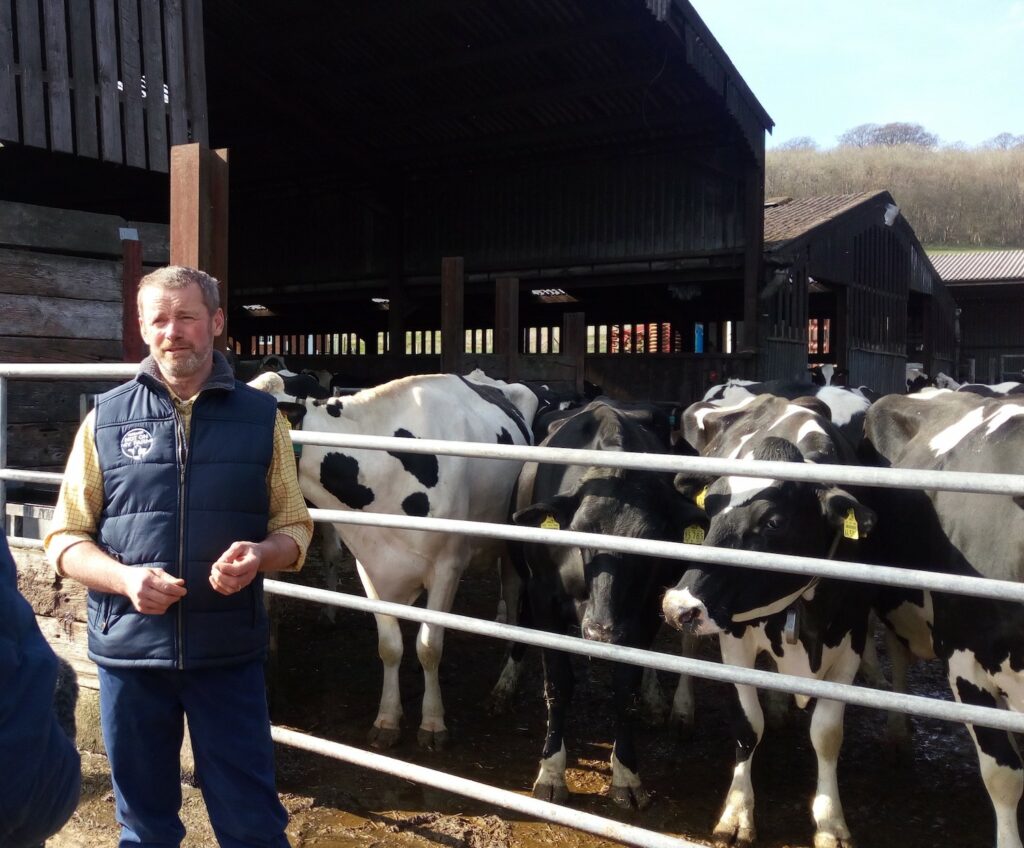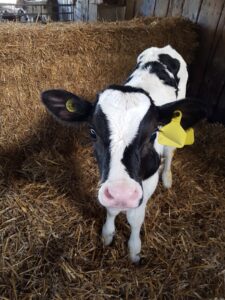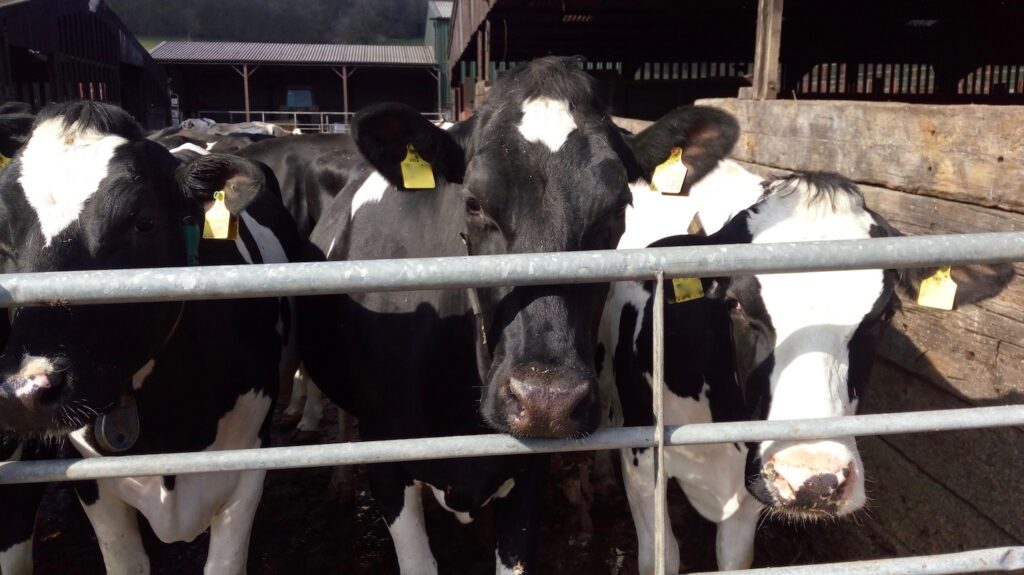Cutting stress can reduce pneumonia risk this winter
8th December 2021
Simple steps can have a big impact in the avoidance of pneumonia during winter housing, and taken early, can drastically cut potential losses. Kat Baxter-Smith, MSD veterinary advisor for ruminants, shares her recommendations alongside tenant dairy farmer and Disease? Not On My Farm! ambassador, William Westacott.

William Westacott runs a herd of 190 Holsteins on the Chevening Estate in Kent.
Although bovine respiratory disease (BRD), or pneumonia, can be caused by as many as 10 different pathogens, many of these frequently exist in the calf’s respiratory tract without causing disease.
However, it is at times of stress that they can cause damage, compromising the calf’s immune system and triggering a disease breakdown. This not only impairs respiratory health and hits performance in the calf itself, but the effects of BRD can continue right through the rearing process and into a dairy heifer’s first lactation.
This has been demonstrated in studies which show that heifers with a history of BRD take, on average, 30 days longer to reach their first calving[1]. And once they’ve got there, their milking performance will also be impaired, with a massive 509 litre production loss, on average, in their first lactation[2].
Potential stressors to avoid
“Pneumonia infections are the most common cause of death in cattle over one month of age,[3]” says Dr Baxter-Smith. “This can be drastically cut by taking measures which reduce the calf’s exposure to stress.”
Stress factors can be a particular challenge during winter housing when temperature fluctuations, hygiene pressures and draughts can come with the territory.
“Pay close attention to ventilation, overcrowding, temperature extremes and draughts as these are all potential stressors which can increase the calf’s susceptibility to disease,” she says.
“Efforts to reduce the animals’ exposure to the bugs which can cause disease should also be made, so hygiene should be a high priority. Equally, air space should not be shared between stock of different age groups, to help minimise the youngstock’s exposure to pathogens circulating in the environment.”
On-farm experience
William Westacott runs a herd of 190 Holsteins on the Chevening Estate in Kent, buying in in-calf heifers from Germany every spring.
“Our herd is extremely naïve coming in, which frightens the life out of me and is why we vaccinated,” he says. “The last time we had a problem with calves was when they were housed in a huge Dutch barn several years ago. […] Six calves came down with pneumonia, simply by changing the airflow. Smoke bombs were essential in tracking down and sorting out the problem, but it was a hard lesson to learn.”
It’s also wise to avoid carrying out several stressful procedures at one time, such as transportation, mixing, weaning or disbudding. Dietary factors also have a role in the avoidance of stress, so it’s important to introduce changes gradually.
“Ensure feed composition is adequate and that the feed is easily accessible,” says Dr Baxter-Smith.
“All calves should also have been given the best fighting chance of fending off disease with plenty of high-quality colostrum, which applies to BRD, just as with other infections.”
Mr Westacott agrees. “We have a lot of vet students on farm and I’m always talking about the importance of ensuring calves receive enough quality colostrum,” he says.
Early life vaccination
Dr Baxter Smith also believes that early life vaccination can also play a part in calf respiratory health, cutting the damage caused by some pneumonia pathogens.
“At this time of year, the focus should be firmly on winter housing, which, if set up well, can create a favourable environment and stack the odds in support of good calf respiratory health,” says the vet advisor.
“But if the best laid plans are challenged, it’s important to be on guard for early symptoms as these can be nipped in the bud and prevented from spreading. Initial signs of pneumonia can be challenging to detect, so be aware that a temperature of 39.5⁰C and above is an early indicator, often before other clinical symptoms occur,” she says.
The six key clinical signs to watch for are:
- Fever
- Lethargy
- Loss of appetite
- Watery eyes
- Nasal fluids
- Coughing.
If such symptoms appear, sick animals should be isolated, avoiding mixing age groups, and veterinary help should be sought.
“The many pathogens which can cause pneumonia will change on the farm over time, so it’s important to get in touch with your vet to arrange diagnostic testing to make sure you’re targeting the right causes of the outbreak,” continues Dr Baxter Smith.
“The livestock sector has taken significant steps in reducing antibiotic use, and disease prevention is by far the best approach in this endeavour,” says Mr Westacott. “This is why initiatives such as Disease? Not On My Farm! are so beneficial as it helps to promote the value of a more preventative herd health approach to farmers and encourages to them to consider all the factors that can reduce the risk of disease.”
“If there is an outbreak, it’s important to act fast, and work with your vet to identify the pathogens which are causing the disease so you can take a targeted approach,” Dr Baxter Smith advises.
Calf pneumonia and steps in its prevention:
- Many bugs can cause pneumonia, or Bovine Respiratory Disease (BRD)
- Some of these pathogens live in the calf’s respiratory tract without causing disease
- Stress can trigger them to cause disease by compromising the calf’s immune system
- Stressful management events include transportation, mixing, weaning and disbudding
- Work with your vet to establish herd management protocols and a vaccination strategy
- Establish protocols to ensure adequate, high-quality colostrum is fed to all calves
- Avoid poor ventilation and hygiene, overstocking, temperature extremes and draughts.
[1] Van Der Fels-Klerx HJ, Saatkamp HW, Verhoeff J and Dijkhuizen AA (2002). Effects of bovine respiratory disease on the productivity of dairy heifers quantified by experts, Livestock Production Science 75(2): 157-166.
[2] Dunn et al. (2018) The effect of lung consolidation, as determined by ultrasonography on first-lactation milk production in Holstein dairy calves, J. Dairy Sci., 101:1-7
[3] NADIS (http://www.nadis.org.uk/bulletins/respiratory-disease-in-dairy-and-beef-rearer-units.aspx)


